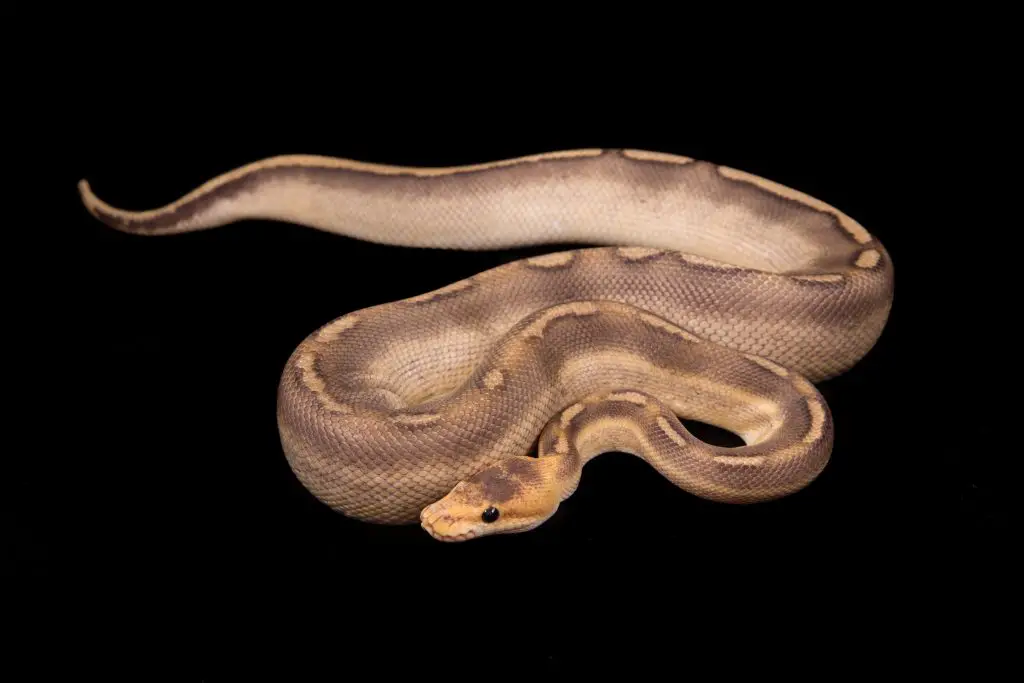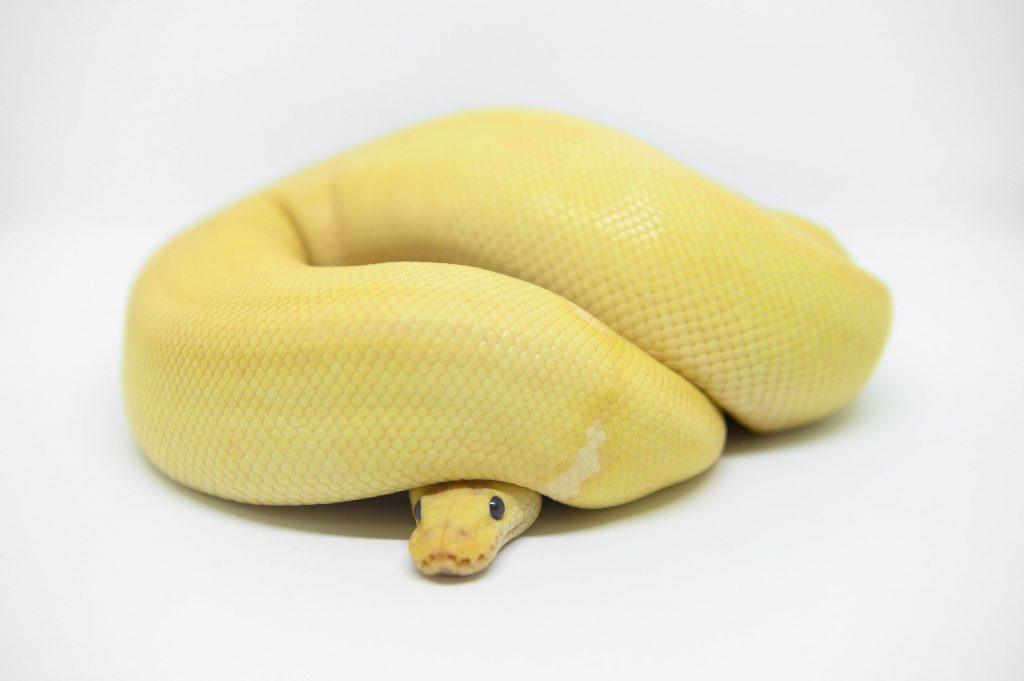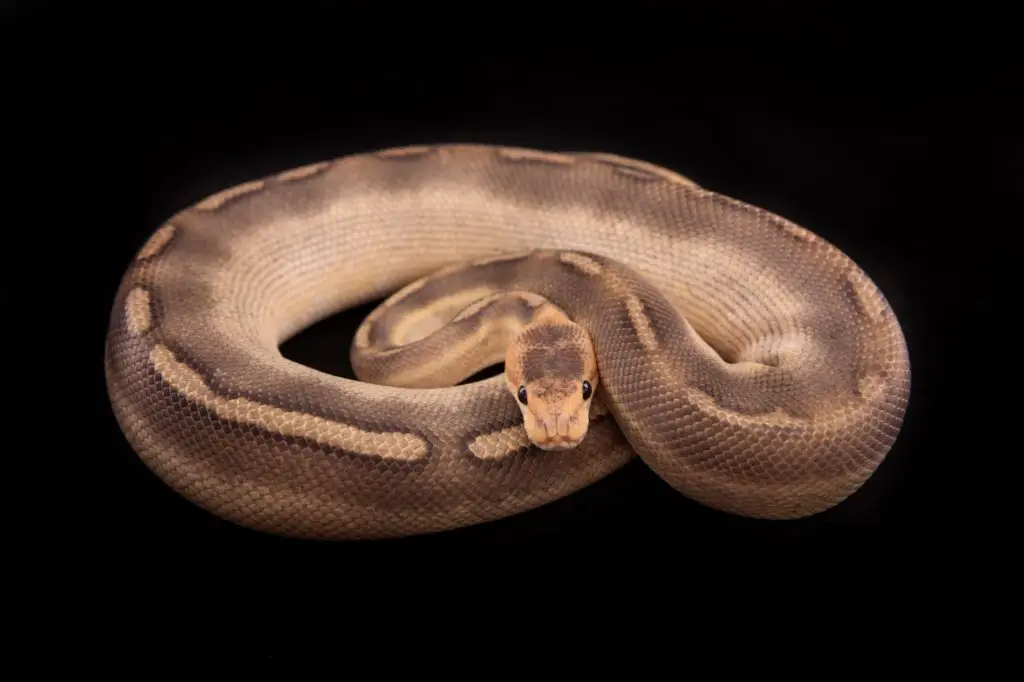The Champagne Ball Python is an unusual morph that completely changes both the animal’s pattern and colouration. First produced by Eb Noah in 2005, it has been reasonably popular ever since.
Morph type
Champagne is a single gene incomplete dominant morph. This type of gene usually produces a super form in its homozygous state, but this does not appear to be viable with the Champagne gene. In fact, super Champagne Ball Python babies usually don’t even hatch.
Description

The Champagne mutation is highly unusual in that it drastically alters the animal’s appearance. So much so that the usual Ball Python pattern and colouration is completely swept away.
On the dorsum, the brown blotches you’d see on a normal Ball Python are completely erased and replaced with one long row of thin blotches. These go on to form an almost continuous stripe on the posterior third of the body.
On the flanks, some spots may be present, or they may simply be pattern-less. Overall, the whole colouration is a light brown “champagne” colour. The ventral scales are white and without markings.
In most animals, the head is a touch lighter, and the lips are white. The belly is generally pure white.
In summary:
- dorsum (back) – brown with lighter stripe down the middle
- flanks – lighter brown, with or without spots
- head – lighter brown down the sides and dark on top
- eyes – black
- lips – white
- belly – white
Do Champagne Ball Pythons have a wobble?
Some Champagne Ball Pythons do have neurological issues not unlike those of the Spider morph. This translates into a head wobble of varying severity. Admittedly, these issues are often grossly exaggerated by those that wish to ban the keeping of exotic animals.
Personally, I haven’t encountered individuals of this morph with severe issues, but I have heard from reliable sources that it does happen.
What is certain is that homozygous, or Super Champagne Ball Pythons, are not viable – they die shortly after hatching if they hatch at all. The same is true for Spider Champagne Ball Pythons.
Breeding tips
As you can tell from the section above, breeding Champagne x Champagne or Champagne x Spider is pointless and should be avoided.
Asides from this issue, the Champagne Ball Python is a stunning morph, and quite unusual in its own right. In fact, it maintains reasonably steady popularity and value as a single gene morph.
Nonetheless, you can do a lot with it. If you want to use it for a breeding project, I recommend using strong dominant genes like Leopard or Enchi to bring in some patterning, alongside Orange Dream, Yellow Belly or Pastel to brighten the combo.
Or, if you want the same effect, but on the darker side, try using Black Pastel, Blackhead or Cinnamon.
If recessive genes are your thing, the Champagne Piebald Ball Python is probably one of the best combinations this gene could be involved in.
However, many combinations that include Champagne and one or more other incomplete dominant mutations have white patches that look like Piebald. You may be able to produce one of these at a much lower cost than a recessive project!
Let’s check out some examples…
Top 5 Champagne Morphs (my choice)
1. Champagne Enchi Yellow Belly Ball Python
This is a really, really, nice combo that isn’t particularly well known despite its incredible appearance. Obviously, part of the challenge with a gene like this is trying to bring in a new aspect, either in the form of different colouration or added pattern. After all, Champagne tends to just swallow everything up!
Fortunately, this morph does both, and does it well. The Enchi gene has a strong influence on pattern and manages to overlay a nice amount of it onto the Champagne background. For its part, the Yellow Belly gene enhances the contrast between this Enchi patterning and brightens the overall colour with a dash of yellow.
The result is light tan to yellow background that contrasts nicely with just the right amount of spotting and blotching.
2. Pastel Champagne Ball Python
Surprise, surprise – we’re going to involve Pastel again! In some morphs Pastel just does so much, so well.
Overall, I would say this is one of the nicest Champagne combos, and once you see it, you’ll be astounded at just how much of an influence Pastel has. In this snake, the whole of the background colouration is much lighter, adding a very different dimension to the Champagne morph.
In amongst the light, yellowish background there is some patterning but not much. If anything, the snake has a very subtle but pretty appearance.
3. Banana Champagne Ball Python

OK, so maybe you’ve just Googled the Pastel Champagne and thought to yourself “I want something more colourful!” Well, if that’s the case, don’t worry – I’ve got you covered.
The Banana Champagne Ball Python is a very intense, predominantly yellow morph. The background of light brown is replaced with the typical yellow of the Banana gene. To offset this solid block of colour, the dorsal dots of pattern are a lighter yellow.
Overall, this morph suits those that simply love yellow snakes. Obviously, you can replace Banana with Coral Glow for the same effect.
4. Champagne Piebald Ball Python
This one has everything to like. As with any Piebald animal, the usual colouration (or in this case the Champagne colouration) is interspersed with bright, cleanly defined patches of pure white. This is refreshing to the eye and gives us that all important ingredient of contrast.
From a financial perspective, acquiring one of these in the aim of adding Pied to a breeding project is never a bad idea. It has enduring popularity and depreciates slowly. Moreover, it works particularly well with low-pattern genes like Champagne.
The only drawback is that some of the heterozygous offspring will have small white patches – be very careful not to sell someone a heterozygous Pied at the price of a visual Pied!
5. Cinnamon Champagne Ball Python
Now over to the dark side… Well, the darker side anyway. In all honesty, Cinnamon goes well with almost anything, having a pronounced effect on both colour and pattern. It should be no surprise to us then that it adds a lot of depth to Champagne combos.
By depth I mean richness and intensity of colour. In this morph the influence of Cinnamon translates into a rich, toffee-coloured dorsal colouration, alongside darker brown, almost slate-coloured flanks. To top it off, these snakes often have a pure white patch or ring near the tail.
Honourable mention: Champagne Clown Ball Python
As you probably already know, Clown is one of the most popular recessive Ball Python morphs around. In fact, its popularity is so great that I’d go as far as to say it will always be one of the most popular morphs.
When you combine these two genes, you get a weird, funky looking snake. Champagne Clowns are yellowy brown with hints of patchy patterning all over. This makes them attractive to those of us that like things that are a little bit weird. Oh, and those of us who like very solid investments!
Champagne Ball Pythons for sale
Given that some Champagne Ball Pythons have slight neurological issues, I recommend that you avoid buying them from pet shops.
Many breeders are now understanding that a head wobble is more often a sign of stress than it is a true disability. In fact, I’ve even seen wobbles disappear completely from Spider Ball Pythons that have been re-homed with more experienced keepers.
The unfortunate truth is that pet shops tend to be very stressful environments for Ball Pythons, and if they have any issues whatsoever, it’s in this kind of situation that it will show up.
My advice is to go to Morphmarket and find a local or very reputable breeder to source a Champagne morph. In this way you’ll get an unstressed snake fully backed by an experienced keeper.
Champagne Ball Python Summary
| First Produced by: | Eb Noah, 2005 |
| Morph type: | Incomplete dominant |
| Genetic issues: | Possible head wobble, not viable in homozygous (super) form |
| Goes well with: | Piebald, dominant/incomplete dominant genes with strong effect on pattern such as Leopard or Enchi |

FAQ related to Champagne Ball Pythons:
Do Champagne ball pythons have issues?
Many, but not all Champagne Ball Pythons have issues due to there genetic mutation being pleiotropic – meaning that it affects more than just color. Some of them will have a head wobble or tremor similar to that seen in the Spider Ball Python, but generally it is less severe.
What is a Champagne ball python?
A Champagne Ball Python is one that has a genetic mutation giving it unusual color and pattern. Hobbyists refer to animals like these as “morphs”. Just like Pastel, the Champagne gene is incomplete dominant (often referred to as co-dom) meaning that it has a super form.
However, where it differs is that the super form is fatal – it’s impossible to make a “super Champagne”, and you should never breed to Champagne Ball Pythons together.
How much do Champagne ball pythons cost?
A Champagne Ball Python should cost you around $150-250 in the US, or as little as £100/€115 in Europe. This makes it more affordable than many morphs, but it can still be expensive if other genes are involved. For example, a Champagne Clown would cost a lot more.
Also on this topic:
- Acid Ball Python: A Complete Morph guide and breeding tips
- Coral Glow Ball Python
- Pastel Ball Python
- Mojave Ball Python: A complete morph guide and breeding tips
- Ivory Ball Python breeding guide
